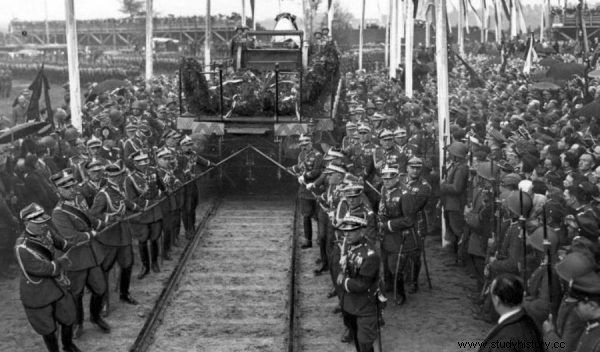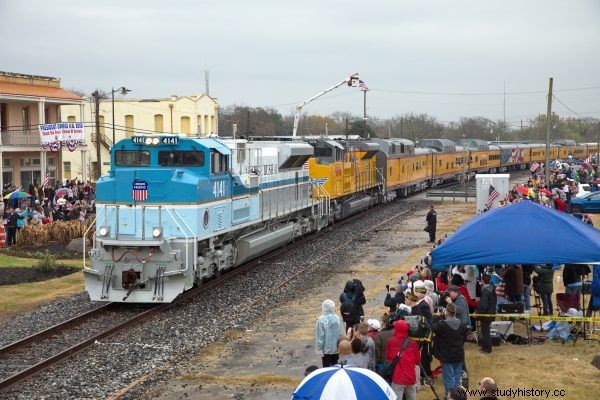Trains and funerals have a lot in common. The railway, almost from its very beginning, was used to transport bodies. The clatter of wheels also accompanied the last journey of many world leaders.
The first funeral trains began to run on November 13, 1854 in England. They carried the dead and accompanying mourners from the London Necropolis station to the Brookwood Cemetery. Operating this line The London Necropolis and National Mausoleum Company offered several classes of compartments to both their living and dead customers , depending on the size of the wallet. Trains ran daily until 1900.
Then the number of courses was reduced, making it dependent on the immediate demand. The company ceased operations on April 16, 1941, when the starting station was destroyed in bombing. Similar lines operated from the 19th century to the mid-20th century also in Australia, Finland and Germany. Due to the nationalization of railway companies and increasingly restrictive sanitary regulations, this form of arriving at the funeral was losing its popularity. This does not mean that it has completely disappeared. The railroad continued to transport the mortal remains of heads of state and statesmen. Among them we can find the names of people who left a significant mark on the history of the world.
Way back home
Abraham Lincoln was the sixteenth president of the United States. He was elected to the post in 1861. During his tenure, the Civil War broke out. He abolished slavery in 1865, which made him many enemies. One of them was an actor, John Wilkes Booth. It was he who, on April 14 of the same year, assassinated Lincoln by shooting him at the Ford's Theater in Washington.

Abraham Lincoln's funeral
The body of the murdered politician was to be transported to the city of Springfield, Illinois, where he lived before assuming the highest office in the state. The Lincoln Speciall train, harnessed to the locomotive The Old Nashville, traveled over 2,500 km (1,600 miles), stopping along the way, incl. in Baltimore, Philadelphia, New York, Cleveland and Chicago. The coffin was put on display at each stop, allowing the Americans to say goodbye to the murdered leader. The train also carried the body of the president's son, who died of typhus in 1861 at the age of just 11.
Driving in freezing cold
Five years after traveling the funeral procession in the USA, at the other end of the globe, in the Volga city of Symbirsk (today's Ulyanovsk), a man was born who also made his last journey by rail. Vladimir Ilyich Lenin, leader of the October Revolution and Soviet Russia, one of the main theorists of communism died in 1924. The official cause of his death is unknown. Documents on this subject are to be declassified by the Russian Archives of Social and Political History only in 2024.

Lenin's Funeral Train
The dead body of the Bolshevik set off on a short journey along frost-covered tracks from the village of Gorky on the outskirts of Moscow to the center of the capital. Then it was displayed in the column hall of the Union House, from where after three days it was transferred to the mausoleum in Red Square.
In the Kremlin, the struggle for power began almost immediately. Mikhail Kalinin, Grigory Zinoviev (twelve years later his show trial and execution started the time of the Great Terror of the USSR) and Joseph Stalin gave their speeches at the funeral. It was significant that Leon Trotsky, Stalin's main opponent, was absent from taking over from Lenin. Despite the prevailing cold, hundreds of thousands of Russians came to say goodbye to the creator of the USSR.
The glow of thousands of fires illuminated Piłsudski's path.
Józef Piłsudski hated doctors. Therefore, despite his deteriorating health, he delayed undergoing examinations. When he collapsed during the Independence Day celebrations in 1934, it was obvious that the marshal was bad. However, the diagnosis was made only after a few months, when it was already late for help.
The opinion of a doctor brought from Vienna, prof. Karel Wenckenbach was the de facto reading of the sentence - liver cancer. The former head of state died on May 12, 1935. National mourning has been declared throughout the country. After the celebrations in Warsaw, the coffin was transported to Krakow, where it was to rest in the crypt of St. Leonard in Wawel.

After Józef Piłsudski's death, a national mourning was announced.
The Os24 steam locomotive set off slowly south. The locomotive pulled 11 wagons, including the most important one - a railway platform with a cannon trailer on which the coffin was lying. Gazeta Kielecka reported:
[..] the expected train is approaching. The command is given. Soldiers are presenting weapons. The crowd bares their heads. A steam locomotive, decorated in national colors, with a large legionary eagle stretched at the front, slowly rolls onto the platform. […]. In the middle of the train, an exposed platform brightly lit by searchlights. All eyes turn to this platform. There is a coffin covered with a white shroud on a cannon carriage, hiding the corpse of the First Knight of the Brightest Republic. On the coffin, a rifle maciejówka and the Marshal's mace.
People lit fires almost along the entire route.
Operation "I wish"
In a BBC vote in 2002, Winston Churchill was named the greatest Briton of all time. The prime minister, who led Britain during World War II, winner of the Nobel Prize in Literature, died on January 24, 1965.
The state funeral that was organized for him (the last such ceremony in the UK to this day) began two days later. Under the decree of Queen Elizabeth II, Churchill's body was exposed for three days at the Palace of Westminster. After the mass, which took place on January 30 at the Cathedral of St. Paul, the body was transported on the Thames by MV Havengore boat to Waterloo train station. There they were transferred to a train pulled by a locomotive named in his honor SR Battle of Britain class 21C151 “Winston Churchill”.

The train carrying Churchill's body
In the five wagons attached to it, apart from the coffin, there was room for mourners, family and friends of the deceased. The journey of about one hundred kilometers passed through Barnes, Twickenham, Virginia Water, Ascot, Wokingham and Reading. Along the route, mourners took off their caps before a passing train, and veterans of the last war, in full uniforms saluted him goodbye. Interestingly, all the details of Churchill's goodbye were settled as early as 1953. Their code name was “Operation LET NO”.
Train Force One
The last state railroad funeral took place quite recently. George H.W. Bush was the 41st president of the United States. Although he only held office for one term, from 1989 to 1993, his reign fell during a very turbulent period in history.

Union Pacific EMD SD70ACe "George Bush 4141" locomotive, painted in the colors of the presidential Air Force One plane
At that time, incl. the Berlin Wall collapsed, the Soviet Union ceased to exist, war broke out in Bosnia and Herzegovina, and its administration became involved in the conflict in the Middle East. He was succeeded by Bill Clinton, and Bush spent the next 25 years in political retirement.
He died on November 30, 2018 at the age of 94. During his lifetime, the president was famous for his love for trains, so it is not surprising that he went to his resting place by this means of transport. The train was pulled by a dedicated Union Pacific EMD SD70ACe "George Bush 4141" locomotive, painted in the colors of the presidential Air Force One plane. Its route was 160 km from the suburbs of Huston to George H.W. Bush Presidential Library and Museum in College Station, Texas, where he is buried.
